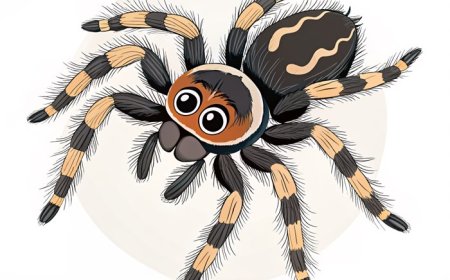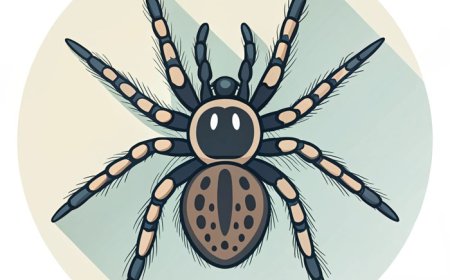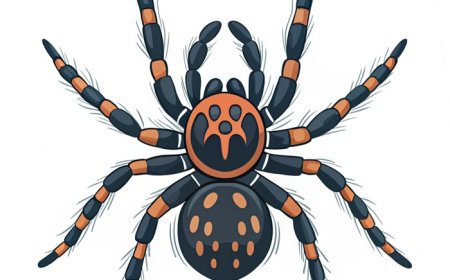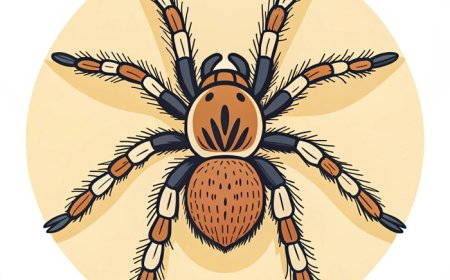Hobo Spider Guide: The Mysterious Tunnel-Weaving Spider
The hobo spider spins funnel-shaped webs and lives close to people. Learn what it looks like, where it hides, and whether its bite is really dangerous.
🕸️ Introduction
The hobo spider is a fast-moving, web-spinning spider that is often found in and around homes in western North America. Known for making funnel-shaped webs, this spider hides in tunnels and rushes out to catch insects. Some people have worried about its bite in the past, but today scientists believe it is not nearly as dangerous as once thought.
Hobo spiders can be helpful by eating pest insects, and like most spiders, they avoid humans. Learning more about them helps us appreciate these mysterious arachnids—and avoid unnecessary fear.
🔍 What Does a Hobo Spider Look Like?
Hobo spiders are medium-sized spiders, with bodies about 1 to 1.5 centimeters (0.4–0.6 inches) long, and their legs can span up to 5 centimeters (2 inches). They are usually brown or gray-brown, with slightly darker markings on their abdomen, sometimes resembling chevrons (V-shapes).
They are often confused with other common brown spiders like house spiders or even brown recluse spiders, though hobos don’t have the violin-shaped mark found on the brown recluse.
Because they are fast runners and tend to stay near the ground, people often spot them scurrying across floors or walls.
🕳️ Do Hobo Spiders Spin Webs?
Yes! Hobo spiders are members of the funnel-web spider family (Agelenidae), meaning they build flat, sheet-like webs with a tunnel or funnel-shaped retreat at one end. They hide inside the funnel and wait for insects to walk onto the sheet.
When the spider feels movement through the web, it dashes out to grab the prey and drag it back into the funnel to eat. Their webs are not sticky, but they are placed in areas where prey is likely to wander, such as along walls, in basements, or in corners near the ground.
🍽️ What Do Hobo Spiders Eat?
Hobo spiders are carnivores that eat:
Ants
Beetles
Flies
Moths
Other small bugs
They are ambush hunters, meaning they wait in their funnel for prey to come to them. They help control pest populations in and around homes and are especially useful in basements and garages.
🌍 Where Do Hobo Spiders Live?
Hobo spiders are found mainly in the Pacific Northwest of North America, including parts of the United States and Canada. They prefer cool, dark places, which is why they are commonly seen in:
Basements
Crawl spaces
Wood piles
Sheds and garages
Low corners of rooms or stairs
Outdoors, they can also be found under rocks, logs, or garden furniture. Because they stay low to the ground, they are more likely to run than climb when disturbed.
🛡️ Are Hobo Spiders Dangerous?
The hobo spider was once thought to have a dangerous bite, possibly causing skin damage. However, recent research shows that their venom is not harmful to humans, and many reported bites were likely caused by other spiders.
Most hobo spiders do not bite unless provoked, and even when they do, the bite usually causes only mild redness or swelling, similar to a bee sting. They do not have venom strong enough to cause serious problems in most people.
Like other spiders, hobo spiders prefer to avoid people, and bites are rare.
🐣 Life Cycle and Behavior
Female hobo spiders lay egg sacs in dark, protected areas of their web. Each sac can hold up to 100 eggs, which hatch into tiny spiderlings. The babies disperse and grow by molting—shedding their outer skin—several times before becoming adults.
Most hobo spiders live for about one to two years. Males often wander in the late summer and fall in search of a mate, which is why they are more likely to be spotted indoors during that time.
🌟 Fun Facts About Hobo Spiders
Hobo spiders build funnel-shaped webs but are different from the Australian funnel-web spider.
They get their name “hobo” because they may have spread by traveling with people and goods.
Hobo spiders are very fast runners, especially when chasing prey or escaping danger.
They were once thought to be dangerous, but scientists now believe they are mostly harmless.
Unlike many spiders, they don’t climb smooth surfaces well and often stay near the ground.
👧 Kid-Friendly Summary
Hobo spiders are small brown spiders that build funnel-shaped webs and live in basements, sheds, and corners. They hunt bugs by waiting for them to walk on their web. Even though some people used to worry about their bite, hobo spiders are now known to be safe and helpful. They don’t want to hurt people—they just want to be left alone.
📚 Vocabulary Words
Hobo spider – A spider that builds a funnel-shaped web and lives near people
Funnel web – A flat web with a tunnel where the spider hides
Ambush – A surprise attack from a hidden place
Molting – Shedding the outer skin to grow
Spiderling – A baby spider
Carnivore – An animal that eats other animals
Basement – A room below ground level in a building
Venom – Poison used by some animals to catch prey (harmless in hobo spiders)
❓ Interactive Quiz (8 Questions)
1. What kind of web does a hobo spider build?
A. Orb web
B. Funnel-shaped web
C. No web
D. Sticky net
2. Where do hobo spiders usually live?
A. In treetops
B. In warm, sunny spots
C. In basements and cool places
D. In water
3. What color is a hobo spider usually?
A. Bright red
B. Black and white
C. Brown or gray-brown
D. Green
4. Are hobo spiders dangerous to humans?
A. Yes, extremely
B. Only at night
C. No, they are mostly harmless
D. Only in summer
5. What do hobo spiders eat?
A. Leaves
B. Other spiders
C. Insects and bugs
D. Grass
6. How do hobo spiders catch their food?
A. Chase it in the open
B. Trap it in a funnel web
C. Sing to attract prey
D. Dive into water
7. What does “molting” mean?
A. Hiding under rocks
B. Eating slowly
C. Shedding old skin to grow
D. Web-making
8. When are hobo spiders often seen inside homes?
A. Late summer and fall
B. Winter mornings
C. Spring rain
D. Full moon nights





















































